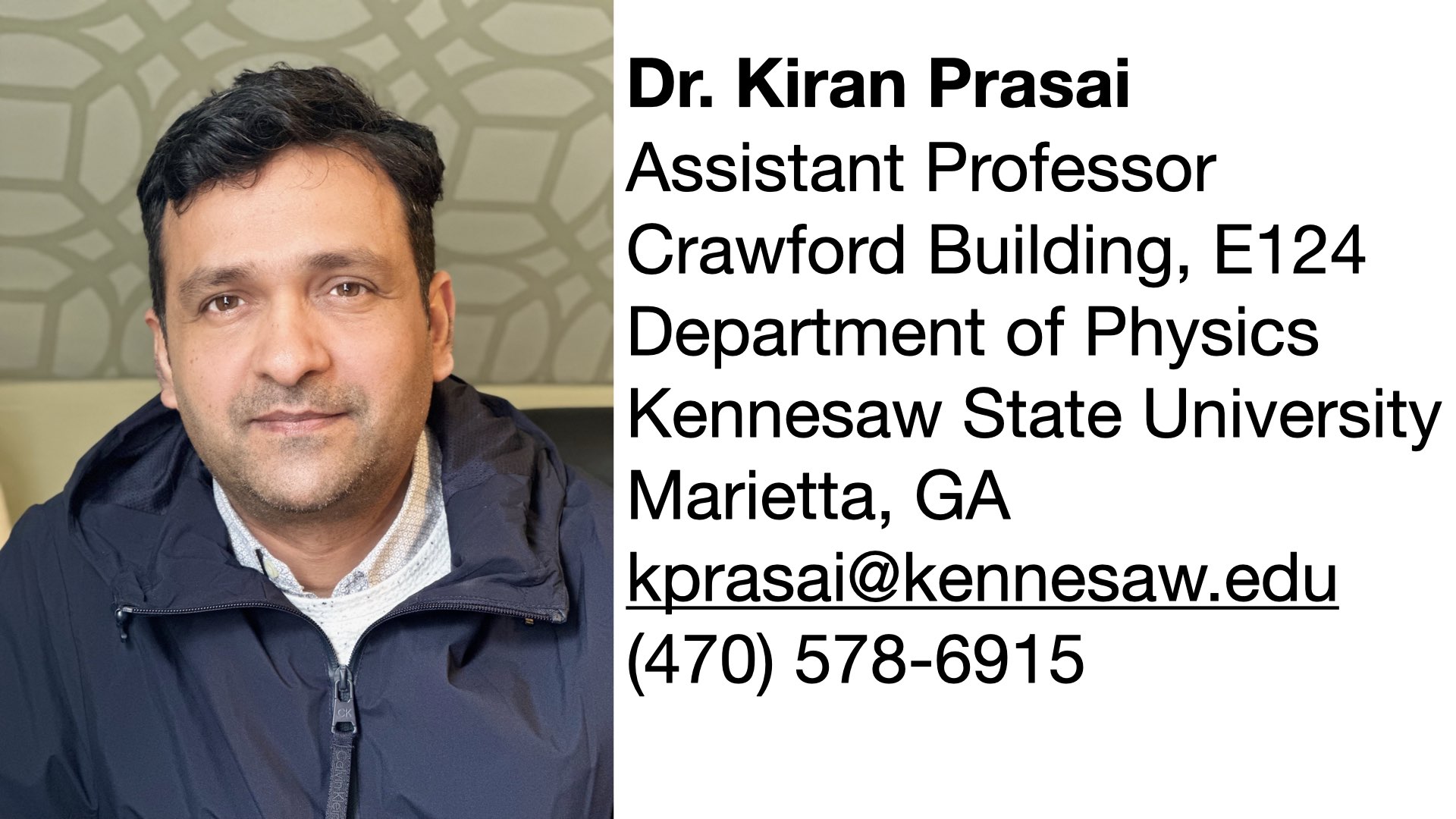Kiran Prasai

Bio/CV
Kiran Prasai earned his Ph.D. in Physics from Ohio University in 2017, where he investigated
the atomic and electronic structure of amorphous materials. His doctoral research
was supported by the prestigious Donald Clippinger Fellowship, for demonstrating “excellence
in research and creativity.”
In 2017, Prasai joined the LIGO group at Stanford University, where he spent next
six years studying optical coating materials for LIGO and other future gravitational-wave
detectors. His research at Stanford centered on atomic structure modeling and x-ray
scattering measurements of sub-micron amorphous films. His work on annealing-induced
effects in amorphous coatings played a key role in the development of TiO2-doped GeO2/SiO2 coatings, which are being developed as part of LIGO’s A+ upgrade.
In 2024, Prasai joined Kennesaw State University as an Assistant Professor, leading
a research group focused on amorphous materials and optical coatings. His group is
a member of the LIGO Scientific Collaboration, a global consortium of over 1,000 scientists advancing gravitational-wave astrophysics.
He is also an active member of the American Physical Society (APS) and the American Ceramic Society (ACerS) and maintains close collaborations with distinguished researchers across
the U.S. and internationally.
Research Interests
Dr. Prasai leads Amorphous Materials and Optical Coating Lab (AMOC Lab) at Kennesaw State University. His lab specializes in the rational design of disordered materials, with a focus on amorphous thin films for advanced applications. They develop and employ complementary computational and experimental methods to explore the relationship between atomic structure and material properties.
A major focus of AMOC lab is to develop high-performance optics for gravitational-wave detectors LIGO, Virgo and beyond. They specialize in understanding how the atomic structure of sub-micron coatings depends on fabrication conditions, dopants and annealing. The lab develops high-precision atomic models informed by X-ray and electron diffraction data, along with machine learning, to gain insights into the effects of deposition, annealing and dopants on material structure.
Selected Publications (For full list, click here)
1. K. Prasai, K. Lee, B. Baloukas, H-P. Cheng, M. Fazio, L. Martinu, A. Mehta, C. S. Menoni, F. Schiettekatte, R. Shink, B. Shyam, G. Vajente, M. M. Fejer, and R. Bassiri, Effects of elevated temperature deposition on the atomic structure of amorphous Ta2O5 films, APL Materials, 11(12), 2024.
2. K. Prasai, J. Jiang, A. Mishkin, B. Shyam, S. Angelova, R. Birney, D. A. Drabold, M. Fazio, E. K. Gustafson, G. Harry, S. Hoback, J. Hough, C. Lévesque, I. MacLaren, A. Markosyan, I. W. Martin, C. S. Menoni, P. G. Murray, S. Penn, S. Reid, R. Robie, S. Rowan, F. Schiettekatte, R. Shink, A. Turner, G. Vajente, H. P. Cheng, M. M. Fejer, A. Mehta and R. Bassiri, High precision detection of change in intermediate range order of amorphous zirconia-doped tantala thin films due to annealing, Physical Review Letters 123 045501 (2019).
3. K. Prasai, K. N. Subedi, K. Ferris, P. Biswas and D. A. Drabold, Spatial projection of electronic conductivity: the example of conducting bridge memory materials, Physica Status Solidi RRL 12 1800238 (2018)
4. K. Prasai, G. Chen, and D. A. Drabold, Amorphous to amorphous insulator-metal transition in GeSe3Ag glass, Physical Review Materials 1 015603 (2017).
5. K. Prasai, P. Biswas and D. A. Drabold, Electrons and phonons in amorphous semiconductors, Semiconductor Science and Technology 31 073002 (2016).
6. K. Prasai, P. Biswas, D. A. Drabold, Sculpting the band gap: a computational approach, Scientific Reports 5 15522 (2015).









